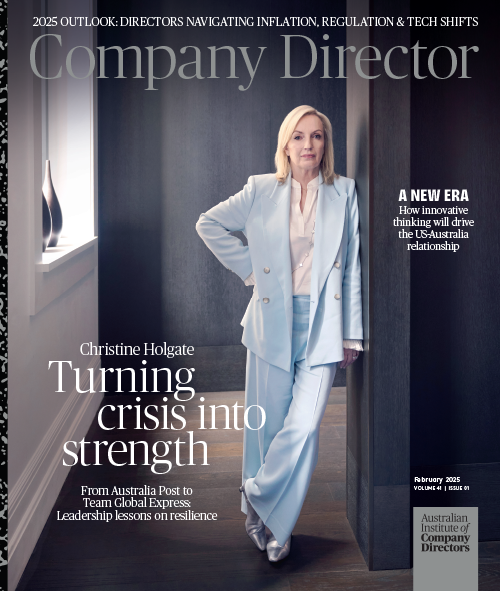We ask a prominent director to share three important lessons from three different professional experiences.
Philip Garling AM FAICD has had a 20-year non- executive career that has included chair and director roles on several ASX-listed companies, private companies, not-for-profits and sporting bodies including the NSW Waratahs and Water Polo Australia. His executive career included stints as CEO of Lend Lease (now Lendlease) Capital Services and Global Head of Infrastructure at AMP.
Garling is chair of Waste Services Group, one of Australia’s largest integrated providers of managed services and collections to the SME market, and of the Newcastle Coal Infrastructure Group. Since 2021, he has served as the president of the Sydney Rugby Union and is a non-executive director of the NSW Rugby Union. He was recently appointed chair of ACEREZ, the consortium contracted by the NSW government to build, own and operate the Central-West Orana Renewable Energy Zone, an estimated $10b project.
The Board: SCEGGS Darlinghurst
The Lesson: A diverse board makes better decisions.
I was asked to join the board of Sydney independent girls’ school SCEGGS Darlinghurst early in my board career. Before then, I’d been on a few boards. They were mostly made up of white, middle-aged men who had gone to private schools. Decisions were made quickly because they were homogenous thinkers.
SCEGGS board members included a social worker, a Crown prosecutor, a minister of religion (previously a vice squad detective), a media personality, a senior arts administrator and a former school headmistress. I found the first six months frustrating because we debated issues at length. During discussions, I’d get impatient. To me, it was obvious what the answer was. Instead, people would throw things out from completely left field as a result of their different backgrounds and perspectives.
After about six months, I realised that although it might have taken a little bit longer to come to a decision, we were making much better decisions because of the diversity of thought that had gone into the discussion on the topic. It was a bit of an epiphany.
In my subsequent board career, I’ve championed the need for diversity. Obviously, it’s a social equity issue — it would be unfair for a section of community not to have the same opportunities as another section. But for me, it’s about performance. If you’re running a team of any size, it will perform better if it comprises a diverse group of people.
The Boards: Various
The Lesson: Devise strategies to prevent a joint venture board from becoming dysfunctional.
When a joint venture sets up a board, each investor and shareholder typically appoints a director to the board. Usually, an independent director is appointed chair. I’ve been that independent chair a number of times. It’s a structure that easily becomes dysfunctional, particularly if those executives leading the negotiation of the JV agreement on behalf of their employer are appointed to the new board.
In one instance, the shareholder- appointed directors began having meetings alone, making decisions on key issues without the involvement of management or chair, potentially leading to a situation where you have the CEO and independent chair versus appointed directors.
Under the Corporations Act 2001, a director is obliged to act in the interests of the company. You can take the interests of the shareholder into account if they don’t conflict with the interest of the company.
I’ve developed strategies to prevent dysfunctional board dynamics arising. Usually, I get the lawyer who drafted the JV agreement to talk to board members at the first board meeting and explain their obligations under the Corporations Act, as quite often, the new directors don’t have extensive board experience.
It’s also important to have a governance structure setting out what are shareholder (not board) decisions. This can prevent potential conflict between the directors’ obligations to their employer and the JV’s interests becoming unmanageable.
The Board: Energy Queensland
The Lesson: Use a skills matrix to recruit directors.
Energy Queensland is one of Australia’s largest government-owned businesses. The Queensland government is its sole shareholder. It was formed in 2016 following the merger of two Queensland government- owned electricity distribution businesses.
I was appointed chair and charged with making recommendations to the government on the composition of the board.
Before I started the recruitment process, I mapped out a skills matrix with the responsible minister and members of the Department of Energy. We were looking for skills and attributes. Skills included experience in the energy regulatory system, legal skills and knowledge of working with government. Attributes included a certain number of board members needing to be regionally based. We also had gender diversity targets.
We used the matrix as a template to recruit directors and we went about it in a disciplined way. It mitigated the risk of the appointments becoming politicised, which sometimes happens with government boards. It worked well and we ended up with a very functional and diverse board. I have endeavoured to develop and use a skills matrix on basically every board ever since.
It is a very good tool in ensuring that my first point — diversity — is achieved in the board composition.
Latest news
Already a member?
Login to view this content



